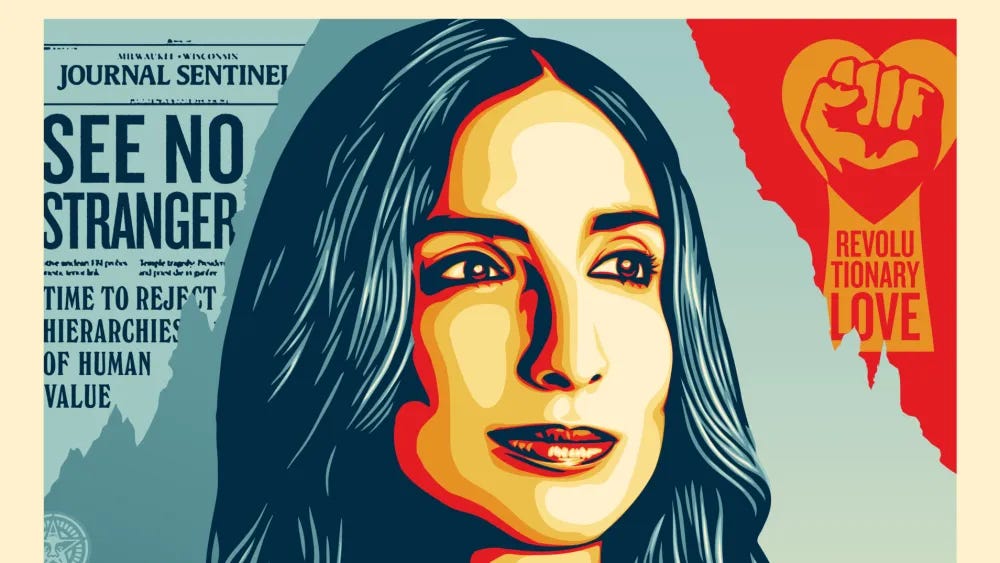"See No Stranger: A Memoir and Manifesto of Revolutionary Love" by Valarie Kaur
Revolutionary Love isn't as hokey as I thought!
If you are someone who wants to start a writing practice but you keep putting it off or there’s a challenging relationship you’re dealing with (even if it’s with yourself) or you don’t know what to do with the the icky stuff that comes up while you’re journaling, I have a free workshop for you! Come to Writing as your Healing Practice: A Workshop to Rewrite Your Relationships in a Dystopian World on 1/21/25 at 4pm PT/7pm ET. REGISTER HERE.
CW: sexual trauma, murder, police brutality
Before reading See No Stranger: A Memoir and Manifesto of Revolutionary Love, I was familiar with Valarie Kaur through memoir excerpts and social media clips of her speeches. The concept of “revolutionary love” sounded inspiring in theory, but I wondered if it might bypass certain realities. This memoir quickly put my doubts to rest.
Kaur’s book is the embodiment of Booker T. Washington’s quote: “I will permit no man to narrow and degrade my soul by making me hate him.” In fact, she references this very quote, making it clear that her work is grounded in fierce compassion.
The book is structured in three parts:
See No Stranger: Loving Others
Tend the Wound: Loving Opponents
Breathe and Push: Loving Ourselves
The opening chapter, Wonder, sets the tone for the entire memoir. Kaur’s descriptive, vivid writing invites readers into a state of wonder and curiosity. She frames wonder as the foundation for revolutionary love—a practice of approaching others with openness, even when we don’t agree. It’s not about becoming best friends with everyone; it’s about seeking understanding.
Reading this book felt deeply personal. Kaur and I were both in college during 9/11, but her experience as a Sikh American was vastly different from mine. While I heard about the violent aftermath Sikhs faced, I didn’t know anyone directly affected. For Kaur, these stories were personal—family friends and loved ones were assaulted or killed in hate crimes fueled by media narratives and white supremacy. Her grief and resilience moved me profoundly as she fought for justice while honoring her community.
Throughout the memoir, Kaur bravely shares her own struggles, including being assaulted by a police officer and navigating the suppressed pain of childhood sexual trauma. She skillfully weaves her activist journey with her personal life, illustrating how our individual and collective wounds are deeply intertwined. Kaur does this through sharing powerful themes like Rage, Listening, Grieving, and Breathing. These elements create a symphony of revolutionary love, offering readers a framework for action.
One of my favorite parts was accompanying Kaur on her unexpected journey to becoming a lawyer. It wasn’t just about her legal career but the mentors, relationships, and experiences that deepened her understanding of why revolutionary love is essential.
The first place I learned that love was an action was from bell hooks’ All About Love: New Visions, which I devoured after I asked for a divorce. I needed a new vision of love—one that wasn’t codependent or constraining. Most recently, I deepended my learning about how love is an action through a podcast I love, (and fellow Substacker) Planet: Critical. In a special Q&A episode, host Rachel Donald discussed love as integral to addressing the polycrisis we face. Like Kaur, Donald’s perspective reinforces that revolutionary love isn’t soft or sentimental—it’s a courageous and relational act.
Valarie Kaur’s story is the embodiment of revolutionary love being an action that isn’t idyllic. It isn’t running through the fields. It is confronting pain and being in conflict with people you love and/or who hurt you while attempting to make sense of it all so you can rediscover the love that has always been and will always be there.
I’m currently learning about Internal Family Systems, also known as Parts Work. My teacher said that our “Self” is the sun and the parts that try to protect us or need protecting are the clouds. Kaur distills the sun from the clouds masterfully with her family of origin, the police officer who hurt her, the person who sexually traumatized her, her body, and the systems of oppression that divide us.
I continue to refine how I visually depict my story for my readers. Do they actually see a scene when I’m writing? Is it specific enough? Is it like they’re watching a movie? See No Stranger does this impeccably, and it was a reminder of how important it is to not just talk about ideas and themes but to immerse the reader in them because knowing is one thing but feeling is what makes the larger impact.
While I don’t intend to include a framework in my memoir, I appreciated how she divided the parts of the book. It made me think about how important it is to show transformation throughout a memoir. Not many people read a memoir, or any story for that matter, for the protagonist to stay in the same place they started. Kaur reminded me of this as I describe the transformation I experienced for the story I want to share.
I highly recommend this beautiful and hopeful read in times of despair. So tell me…




